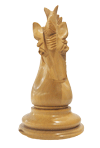Rules & Regulations
Chess is played on a square board of eight rows (called ranks and denoted with numbers 1 to 8) and eight columns (called files and denoted with letters a to h) of squares. The colors of the sixty-four squares alternate between light and dark, and are referred to as "light squares" and "dark squares". The chessboard is placed so that each player has a white square in the near right hand corner, and the pieces are set out as shown in the diagram, with each queen on a square that matches its color.
Each player begins the game with sixteen pieces: each player's pieces comprise one king, one queen, two rooks, two bishops, two knights and eight pawns. One player, referred to as White, controls the white pieces and the other player, Black, controls the black pieces; White is always the first player to move. The colors are chosen either by a friendly agreement, by a game of chance or by a tournament director. The players alternate moving one piece at a time (with the exception of castling, when two pieces are moved at the same time). Pieces are moved to either an unoccupied square, or one occupied by an opponent's piece, capturing it and removing it from play. With one exception (en passant), all pieces capture opponent's pieces by moving to the square that the opponent's piece occupies.



